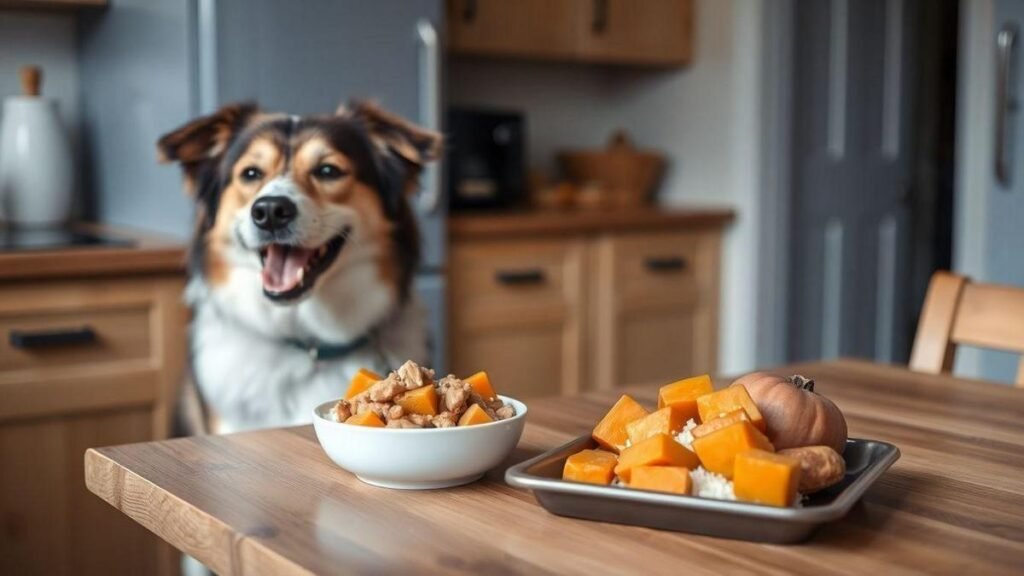Alimentos caseiros para cães com alergias alimentares e dieta balanceada is what I guide you through with care. Managing allergies can feel worrying, so I explain the nutritional basics dogs need — protein, fat, carbs, vitamins, and minerals — and show how simple homemade foods can meet those needs. I walk you through spotting allergens and running an elimination diet, recommend safe ingredients and novel proteins, share grain-free recipes, and give easy meal templates. I also cover portioning, calories, cooking, storage, and hygiene, plus supplements vets may use. I keep it simple and doable. For broader pet care context, see this guide to caring for pets.
Key takeaway
- Pick one simple protein (e.g., fish or turkey) to spot allergies quickly.
- Feed plain carbs (sweet potato or rice) to soothe the stomach.
- Avoid common triggers: beef, chicken, dairy, wheat, soy.
- Cook food plain — no salt, spices, garlic, or onions.
- Watch for reactions and consult your vet before major changes; read more on the importance of routine vet visits.

Nutritional basics for Alimentos caseiros para cães com alergias alimentares e dieta balanceada
Dogs with allergies still need a balanced diet built around five key nutrients:
| Nutrient | Main job | Simple source examples |
|---|---|---|
| Protein | Tissue repair, immune health | Turkey, fish, rabbit |
| Fat | Energy, coat & skin health | Fish oil, olive oil |
| Carbs | Digestible energy, fiber | Sweet potato, rice, pumpkin |
| Vitamins | Metabolism, immunity | Cooked liver (small amount), veg |
| Minerals | Bones, nerves, enzymes | Eggshell powder (calcium) |
I keep meals simple: one safe protein, one safe carb, a healthy fat, and a vitamin/mineral boost.
How homemade foods meet those needs
Choose a single-protein for testing and one gentle carb. Add a small amount of fat and a calcium/multivitamin if needed.
Examples:
- Single protein: rabbit or white fish — less common than chicken.
- Gentle carb: sweet potato or plain rice.
- Healthy fat: fish oil or olive oil.
- Vitamins/minerals: cooked carrot, green beans, eggshell powder.
Rotate foods slowly and watch for rashes, ear infections, or itchy skin. Improvement points to a tolerated diet. Consider using mealtime to reinforce good habits — see tips on using mealtime as training opportunities.
Measuring portions & calories
Simple formula for adult dogs:
Daily calories = 30 × weight (kg) 70.
Macro targets (by calories): 25–30% protein, 30–50% fat, 20–40% carbs (adjust by activity).
Example for 10 kg dog:
- Daily calories = 30 × 10 70 = 370 kcal
- Protein ~30% = 111 kcal → ÷4 = 28 g protein
- Fat ~40% = 148 kcal → ÷9 = 16 g fat
- Carbs rest ≈ 28 g carbs
Weigh cooked food with a kitchen scale, use measuring spoons, and split totals into 2–3 meals. Adjust calories by ~10% if weight changes.
Identifying food allergens & using an elimination diet
Common triggers: beef, dairy, chicken, wheat, soy. Signs include itchy skin, ear infections, GI upset, or chronic licking.
| Allergen | Common signs | Notes |
|---|---|---|
| Beef | Itching, ear problems | Very common in adults |
| Dairy | Diarrhea, gas | May be lactose intolerance |
| Chicken | Hot spots, licking paws | Found in many commercial foods |
| Wheat | Itchy ears, GI upset | Often mixed with other grains |
| Soy | Itching, bloating | In treats or cheap kibble |
Start with your vet; blood and skin tests can help but have limitations for food allergy. An elimination diet with a novel protein or hydrolyzed food is the most reliable method. Stop all treats and flavored supplements, monitor closely, and keep a daily log. If you have more than one pet, prevent cross-contact by planning separate feeding spaces — see ideas for indoor feeding stations for multi-pet homes.
Timeline for an elimination diet
- Week 0: Start diet; record baseline symptoms.
- Week 2: Look for early improvement.
- Week 4: Expect steady gains for many dogs.
- Week 6–8: Major improvement likely if food was the cause.
- Rechallenge: Reintroduce one old ingredient for 1–2 weeks; if symptoms return, that confirms the trigger.
Log food, stool quality, scratching, ears, and mood — photos help.
Safe ingredients & hypoallergenic swaps
Keyword focus: Alimentos caseiros para cães com alergias alimentares e dieta balanceada — recipes should match this goal: home foods for allergic dogs that are balanced.
Principles:
- Use single-protein meals to spot triggers.
- Try novel proteins when common proteins cause reactions.
- Swap common allergens for hypoallergenic options.
Novel proteins
Try proteins your dog hasn’t eaten before:
| Protein | Why | Cooking tip |
|---|---|---|
| Duck | Less common in commercial food | Roast or slow-cook; remove skin |
| Rabbit | Very lean; rarely allergenic | Boil or stew; shred for small dogs |
| Venison | Novel, iron-rich | Cook well; trim silver skin |
| Single-fish (e.g., cod) | Gentle for skin | Steam or bake; avoid bones |
Keep one protein per meal, and watch for reactions for 2–6 weeks after changes. When avoiding flavorings, take the same precautions you would with essential oils and scented products around pets — review safe use in this guide to essential oils around pets.
Grain-free and low-allergy carb options
Many allergy-friendly recipes use sweet potato, pumpkin, or rice (if tolerated).
| Recipe type | Main carbs | Notes |
|---|---|---|
| Grain-free | Sweet potato, pumpkin | Mash or steam; small pieces for small dogs |
| Low-allergy with grain | Rice (white/brown) | Cook plain; test in elimination diet |
| Mixed veg | Green beans, carrots | Lightly cooked for digestion |
If stool becomes loose, drop rice and try sweet potato-only.
Single-protein meal templates (sample daily plans)
I plan meals around one protein plus safe sides and a measured fat.
| Plan | Protein | Veggies | Carb | Fat / Extras |
|---|---|---|---|---|
| Small dog | Rabbit (100 g) | Green beans (25 g) | Sweet potato (50 g) | 1 tsp olive oil |
| Medium dog | Duck (200 g) | Carrot (40 g) | Cooked rice (100 g) | 1 tsp fish oil |
| Large dog | Venison (350 g) | Pumpkin puree (80 g) | Sweet potato (150 g) | 1 tbsp coconut oil |
| Fish day | Cod (150 g) | Zucchini (50 g) | Sweet potato (80 g) | 1 tsp fish oil |
Use one plan for 4–8 weeks for trials. Log servings, skin, and stool.

Simple hypoallergenic recipes & treat ideas
Keep treats aligned with the main diet. Use one protein or one vegetable per treat.
| Treat | Main ingredient | How to make |
|---|---|---|
| Frozen pumpkin bites | Plain pumpkin | Mix pumpkin and a little rice, freeze |
| Dehydrated turkey strips | Turkey breast | Slice thin, bake low until dry |
| Sweet potato chips | Sweet potato | Slice, bake until crisp |
| Oat & meat bars | Cooked protein oats | Mix, press, bake until firm |
Homemade hypoallergenic kibble: blend cooked protein, cooked carb, and ground oats; press thin, bake until firm; cut and store refrigerated.
Cooking methods to preserve nutrients & reduce allergen risk
- Boiling/Simmering — plain and easy to digest.
- Steaming — preserves vitamins.
- Slow cooking — breaks down proteins for sensitive stomachs.
- Baking (low temp) — good for treats and kibble.
Avoid spices, onions, garlic, and heavy oils. Wash tools between different foods to prevent cross-contact — for everyday cleaning tips for pet areas, check keeping food and water areas clean and safe and general guidance on maintaining a clean, comfortable pet environment.
Food prep, storage & hygiene
Follow safe temps and avoid cross-contamination.
| Protein type | Min internal temp (°F) | (°C) |
|---|---|---|
| Poultry | 165°F | 74°C |
| Ground meats | 160°F | 71°C |
| Whole cuts | 145°F 3 min rest | 63°C rest |
Fridge ≤ 40°F (4°C), freezer ≤ 0°F (-18°C).
| Storage method | Safe time |
|---|---|
| Fridge — cooked meals | 3–4 days |
| Freezer — frozen portions | Up to 3 months (best quality) |
| Fridge after thawing | 1–2 days (do not refreeze uncooked) |
Label containers: date cooked, main protein, portion size, notes (e.g., no dairy). Batch-cook in small amounts, portion before freezing, cool quickly in shallow containers. Thaw in fridge overnight or in cold water; reheat to 165°F (74°C) if using microwave. If you clean while pets are in the home, follow safe routines to keep pets protected during chores — see keeping pets safe during cleaning. Also consider how your overall indoor setup supports feeding and storage by reading about creating a pet-friendly indoor space.
Supplements & vet support
I work with my vet before adding supplements. Common recommendations:
- Omega-3 — reduces skin inflammation, supports coat.
- Calcium — needed if meals lack bone or dairy.
- Complete multivitamin — fills nutritional gaps.
Never guess doses — record weight and ask your vet for exact amounts. For guidance on when to involve your veterinarian, see the article on the importance of routine vet visits.
Monitoring progress & when to seek help
Daily checks and weekly weigh-ins help identify issues early:
- Weigh weekly; >5% change → call vet.
- Inspect skin & coat daily for increased itching.
- Check stools every potty; soft or bloody → stop diet and call vet.
- Severe signs (labored breathing, swelling, hives) → emergency care.
Follow-up schedule I use:
- Vet check at 2–4 weeks after diet change.
- Review at 8–12 weeks with labs if needed.
- Then every 3–6 months while refining the plan.
Bring food notes, weight log, photos, and supplement list to visits.
Conclusion
Keep meals simple, use a single-protein during trials, and always consult your vet. Build a clear roadmap: choose a novel protein, pair with a gentle carb (sweet potato or rice), add measured fat, and vet-approved supplements when needed. Weigh food, log symptoms, and be patient — an elimination diet takes time but gives honest answers. Lock down hygiene, storage, and safe temperatures — food safety isn’t optional.
Alimentos caseiros para cães com alergias alimentares e dieta balanceada works when planned carefully. Slow down, make one change at a time, take photos, and celebrate small wins. When in doubt, call your vet. If you’re preparing your home layout or bringing in a new pet while changing food routines, this preparation guide for new dogs and cats can help.
For more practical ideas and recipes, visit https://blogcraelo.com.
Frequently asked questions
Q: What is a simple allergy-friendly homemade meal for dogs?
A: Plain boiled turkey with mashed sweet potato and a little cooked pumpkin — gentle and widely tolerated.
Q: How can I tell if my dog has a food allergy?
A: Look for itchy skin, ear infections, or digestive upset. Note timing after meals and consult your vet.
Q: Can I make a balanced diet at home for my allergic dog?
A: Yes, with recipes that cover protein, carbs, fats, and vitamins. Follow Alimentos caseiros para cães com alergias alimentares e dieta balanceada principles and vet guidance. Use supplements only when advised.
Q: Which proteins are safest for dogs with allergies?
A: Novel proteins like duck, rabbit, or venison are often safer when common proteins cause reactions. Introduce slowly and monitor.
Q: How do I switch my dog to homemade allergy-friendly meals safely?
A: Transition over 7–10 days by mixing old with new food, start small, watch closely, and contact your vet if allergic signs return.
Alimentos caseiros para cães com alergias alimentares e dieta balanceada — with a well-structured plan, careful monitoring, and vet support, homemade feeding can be both safe and effective for allergic dogs.






